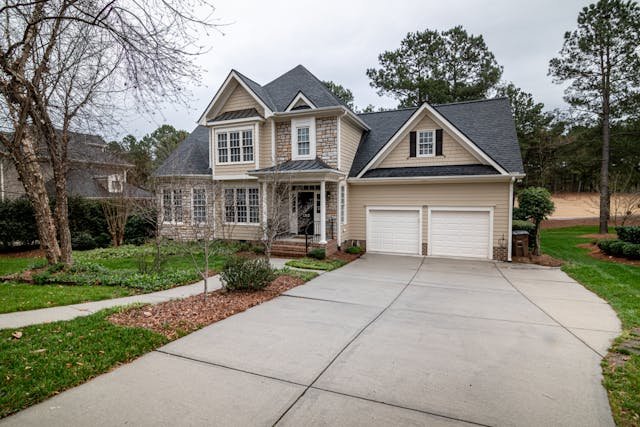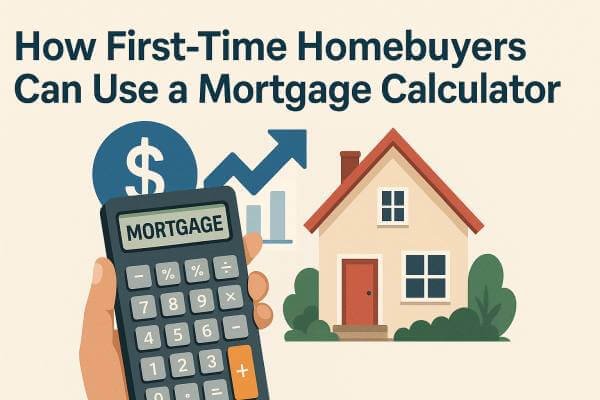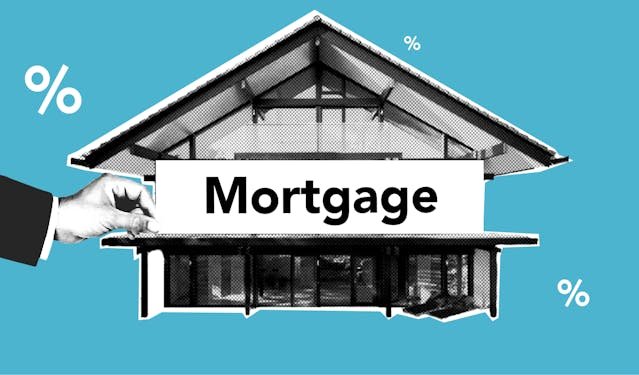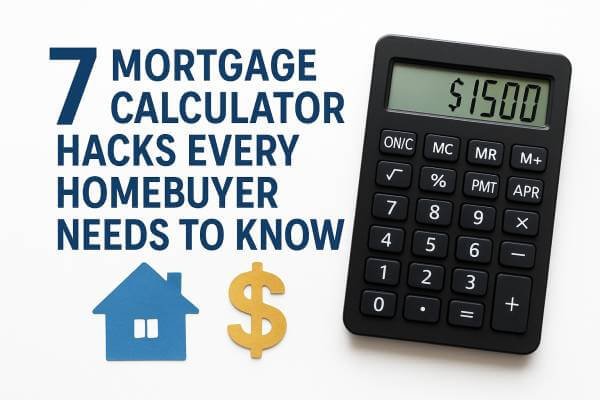How to Use a Mortgage Calculator to Estimate Your monthly payment

Are you curious about the process of using a mortgage calculator to calculate your monthly payment? You’re in the right place. Whether you’re purchasing your first home or simply unsure about your affordability, a mortgage calculator is an invaluable tool. It helps you break down the numbers so you’re not left guessing or stressing.
In just a few clicks, you can estimate how much you’ll pay each month based on your loan amount, interest rate, down payment, and more. It’s quick, easy, and way less confusing than trying to do it all manually.
Let’s walk through how to use a mortgage calculator in a smart way so you can plan better, budget smarter, and feel much more confident about your homebuying journey.
What Is a Mortgage Calculator?
A mortgage calculator is a simple online tool that helps you estimate your monthly home loan payment before you ever talk to a lender. Simply input a few numbers, such as the home’s price, your down payment amount, the interest rate, and the loan term, and the calculator will calculate the monthly payment for you.
Instead of guessing what your payment might be, a mortgage calculator gives you a close estimate based on real inputs. You can play with the numbers until you find a payment that fits your budget.
Whether you’re buying a house, refinancing, or just daydreaming about a place of your own, this little tool can give you clarity fast.
What You’ll Need Before Using a Mortgage Calculator
Before you dive into the numbers, it helps to have a few key details ready. Don’t worry, nothing too technical. To get the best results from your mortgage calculator, you should collect (or estimate) the following:
- Home Price: How much are you planning to spend on the house? This information is usually the starting point. Even if you’re just browsing, pick a ballpark number to work with.
- Down Payment: This value is the amount you’ll pay upfront. Most calculators let you enter a percentage (like 5%, 10%, or 20%) or a flat dollar amount. Remember, the more you put down, the less you’ll borrow and the lower your monthly payment.
- Interest Rate: You can use today’s average mortgage rates as a reference or plug in a rate you’ve been offered by a lender. A small change in the rate can make a big difference, so try a few options to see how it affects your payment.
- Loan Term: The loan term is how long you’ll be paying off the mortgage, typically 15, 20, or 30 years. A shorter term means higher payments but less interest over time.
- Property Taxes: These vary based on where you live, but many mortgage calculators include a field for estimated yearly taxes. If you’re unsure, 1–2% of the home price is a decent starting guess.
- Homeowners Insurance: Some calculators ask for this number too. It protects your home in case of damage or disasters. What is the average cost? It is approximately $1,000 per year, although this can vary depending on your location and the value of your home approximately $1,000 per year, although this can vary depending on your location and the value of your home.
- HOA Fees (If Applicable): If the home is part of a homeowners association, you might owe monthly fees. Be sure to include those, or your monthly estimate could be way off.
Tip: Even if you’re just exploring, it’s worth using conservative estimates so you don’t overextend your budget later.
Step-by-Step: How to Use a Mortgage Calculator Effectively
Now, let’s walk through exactly how to use it the right way so your results are actually helpful.
Step 1: Enter the Home Price
This is the total cost of the home you’re interested in buying. If you’re just starting your home search, use an estimate based on homes in your desired area. For example, if most homes are around $350,000, plug that in.
Step 2: Add Your Down Payment
The down payment is the amount of money you’ll pay upfront toward the home. Most mortgage calculators will let you enter this as either a dollar amount or a percentage.
- Example: If you plan to put down 10% on a $350,000 home, that’s $35,000.
- The bigger the down payment, the smaller your loan and the lower your monthly payment.
Step 3: Choose a Loan Term
Pick how long you want to repay the loan. The most common choices are
- 30 years – Lower monthly payments, but more interest paid over time
- 15 years – Higher payments, but less total interest and faster equity build-up
- 20 or 25 years – A balance between the two
Experiment with various terms to observe how your payment adjusts. It’s eye-opening!
Step 4: Enter the Interest Rate
This is the rate your lender charges to loan you money. If you haven’t been pre-approved yet, use a ballpark based on current national averages. You can find those online in seconds.
Tip: Even a 0.5% change in interest rate can add up to thousands of dollars over the life of the loan. Try a few different rates and see how they affect your monthly payment.
Step 5: Include Property Taxes and Insurance
Some calculators ask for this; others don’t. If your calculator requires it, please include the estimated annual property taxes and homeowners insurance. These are real costs you’ll pay monthly through escrow, so don’t skip them.
- Property taxes vary by location but usually range from 1% to 2% of the home’s value annually.
- Homeowners insurance often runs between $800 and $1,500 per year depending on the property.
Step 6: Add PMI or HOA Fees (If Needed)
- PMI (Private Mortgage Insurance) is usually required if your down payment is less than 20%.
It can cost anywhere from $30 to $150+ per month depending on your loan amount. - HOA fees apply if the home is in a managed community, like condominiums or gated neighbourhoods. The monthly HOA fees can range from $100 to $500 or more.
Step 7: Hit Calculate
Now you’ll see your estimated monthly payment. But don’t stop there; use this tool like a sandbox. Change the numbers. Try out different home prices, down payments, or loan terms. This technique is how you figure out what actually fits your budget before getting in too deep.
Breaking Down Your Monthly Mortgage Payment
Once you’ve used a mortgage calculator and gotten your monthly estimate, it’s important to understand what that number actually includes. Most people are surprised to learn that their payment isn’t just about paying back the loan.
Here’s a full breakdown of the typical costs included in a mortgage payment and why they matter when using a calculator.
- Principal: This is the base loan amount you borrowed from the lender (after your down payment). Each month, a portion of your payment gradually reduces that balance. Over time, the amount going toward principal increases, while interest decreases.
The principal is what builds your equity, which is your ownership stake in the home.
- Interest: This is what the lender charges you for borrowing money. It’s based on your interest rate and your remaining loan balance. In the early years of your loan, most of your payment goes toward interest, not principal.
Example: On a 30-year loan, don’t be surprised if more than 70% of your early payments go toward interest alone.
- Property Taxes: These are set by your local government and typically based on your home’s value. Lenders usually collect them monthly as part of your mortgage payment, then pay the tax bill on your behalf through an escrow account.
- Estimate: 1%–2% of your home’s value per year
- Monthly impact: $250–$500/month on a $300,000 home (depending on your state or county)
Your mortgage calculator may ask for this number. If not, add it manually for a more realistic monthly total.
- Homeowners Insurance: Lenders require insurance to protect your home against damage (fire, storms, theft, etc.). Like property taxes, this cost is often collected monthly into escrow and paid annually by your lender.
- Typical cost: $800–$1,500 per year
- Monthly estimate: $70–$125/month
Don’t skip this field if your calculator gives you the option to include it!
- Private Mortgage Insurance (PMI): If you’re putting down less than 20%, most lenders will require PMI. It protects the lender, not you, in case you default on your loan. PMI is added to your monthly payment until you build at least 20% equity.
- Cost: 0.5% to 1% of your loan amount per year
- Example: On a $250,000 loan, that could be $100–$200/month
Many mortgage calculators include this if your down payment is below 20%. Be sure it’s turned on!
- HOA Fees (If Applicable): If the property is part of a homeowners association, like a condo, townhome, or community with shared amenities, you’ll likely pay monthly dues.
- Range: $50 to $500+ per month depending on location and amenities
- Not all calculators include this, so it’s smart to add this number manually if needed.
Optional Costs (Less Common, But Worth Noting)
- Flood insurance (if the home is in a high-risk zone)
- Special assessments or city fees
- Mortgage life insurance (optional, but sometimes included in bundled quotes)
Why This Matters When Using a Mortgage Calculator
Some online calculators only show the principal + interest, which makes your monthly payment look smaller than it really will be. That’s fine for a quick look, but not for serious planning.
To avoid surprises down the road, make sure your calculator includes (or you manually add):
- Property taxes
- Insurance
- PMI (if applicable)
- HOA fees (if applicable)
Ultimately, the usefulness of a mortgage calculator lies in its ability to accurately reflect all the typical monthly costs you’ll actually incur. If you get this right, you’ll be able to budget like a homeowner before you even sign the documents.
Deciding How Much House You Can Afford
Now that you know what’s included in your monthly payment, the next question is, how much can you actually afford?
This is where a mortgage calculator goes from being just a tool to becoming a serious money-saver. Instead of just dreaming about a house you want, you can figure out the house you can realistically afford without wrecking your budget.
1. Start With Your Budget, Not the Loan Limit
Lenders may approve you for more than you’re comfortable spending. That’s why it’s smarter to base your decision on your lifestyle, not just the bank’s numbers.
Ask yourself:
- How much can I comfortably spend each month on housing?
- Will I still have room for other goals—like saving, travelling, or starting a family?
- What happens if something unexpected (like a job change) comes up?
A good guideline: Try to keep your total monthly mortgage payment under 30% of your gross income.
2. Use the Calculator in Reverse
Most people enter a home price and see what the payment looks like. But you can flip that!
Instead, start with your ideal monthly payment, say, $1,800, and plug in numbers until you land on a home price that matches. This approach helps you stay within a monthly range that fits your comfort zone.
3. Consider Your Down Payment + Extra Costs
A larger down payment means smaller monthly payments—but don’t drain your entire savings. You’ll still need cash for:
- Closing costs (2–5% of the home price)
- Moving expenses
- Emergency repairs or upgrades
- A financial cushion for the unexpected
Make sure your mortgage doesn’t leave you house-rich but cash-poor.
4. Plan for Rate Changes or Higher Costs
Even if you get a fixed-rate loan, other costs can go up over time, like property taxes, insurance, or HOA fees. Use the calculator to test a few different scenarios:
- What if rates jump by 1%?
- What if your taxes go up after a reassessment?
A little planning now = less stress later.
5. Keep Your Lifestyle in the Picture
Your home is important, but so is your life. Don’t sacrifice everything else to stretch into a bigger mortgage. The “right” house is the one that lets you enjoy your life outside of it, too.
Quick takeaway: A mortgage calculator isn’t just for playing with numbers. It’s a decision-making tool. Use it to determine a payment that feels safe and sustainable, not just to satisfy a lender’s requirements.
Quick Example: Let’s Crunch the Numbers Together
Let’s walk through a realistic example to see how much house someone can afford and how a mortgage calculator helps break it all down.
Meet Sarah
- Gross monthly income: $6,000
- Comfortable max housing budget: $1,800/month (30% of income)
- Down payment saved: $40,000
Step 1: Plug Into the Mortgage Calculator
Sarah enters the following:
| Input | Value |
| Home price | $300,000 |
| Down payment | $40,000 (13.3%) |
| Loan amount | $260,000 |
| Interest rate | 6.5% |
| Loan term | 30 years |
| Property taxes (annual) | $3,600 (~1.2%) |
| Homeowners insurance (annual) | $1,200 |
| PMI | Yes (since < 20% down) |
| HOA fees | None |
Step 2: See the Estimated Monthly Payment
Based on those inputs, the mortgage calculator shows this:
| Payment Component | Monthly Cost |
| Principal & Interest | $1,643 |
| Property Taxes | $300 |
| Homeowners Insurance | $100 |
| PMI | $100 |
| Estimated Total | $2,143 |
Result:
Sarah’s estimated monthly payment is $2,143, which is over her $1,800 target. That’s a red flag. It’s time to make necessary adjustments to the numbers.
Step 3: Adjust for Affordability
To get closer to her $1,800 comfort zone, Sarah tries:
- Lowering the home price to $260,000
- Keeping her $40,000 down payment (now 15.4%)
- Same rate, term, and taxes
Now, her monthly payment is detailed as follows:
| Component | Monthly Cost |
| Principal & Interest | $1,424 |
| Taxes & Insurance | $320 |
| PMI | $75 |
| New Total | $1,819 |
That’s much better. She’s within $20 of her target, giving her room to breathe and plan with confidence.
Takeaway: This is precisely how a mortgage calculator helps you reverse-engineer affordability. Instead of asking, “How much can I borrow?” You’re asking, “What fits my budget?”
How to Lower Your Monthly Mortgage Payment
There are smart ways to bring that payment down without sacrificing your dream of owning a home.
Here are some strategies you can try:
1. Increase Your Down Payment
The more money you put down upfront, the less you borrow, and that means a lower monthly payment. A bigger down payment can also help you avoid PMI (private mortgage insurance), which can easily add $100–$200/month.
Example: Putting down 20% on a $300,000 home means no PMI, and you’d only need to borrow $240,000 instead of $270,000 or more.
2. Choose a Longer Loan Term
A 30-year loan spreads your payments out more than a 15- or 20-year loan, making each monthly bill smaller. You’ll pay more interest over time, but your monthly cash flow will be easier to manage.
It’s a trade-off: lower monthly payments now vs. higher total interest over time.
3. Shop Around for a Better Interest Rate
Even a small difference in interest rate can knock $100+ off your monthly payment. Don’t settle for the first rate you see. Get quotes from multiple lenders and negotiate.
Pro tip: Improving your credit score before applying can also help you qualify for better rates.
4. Buy in an Area With Lower Property Taxes
Property taxes vary a lot from one county or city to another. A lower tax rate can save you hundreds per year or more. If you’re flexible on location, use the calculator to compare homes in different ZIP codes.
5. Avoid or Reduce HOA Fees
Some homes come with high monthly homeowners association (HOA) fees, especially in gated communities or condos. These are added to your mortgage payment total, so choosing a property with lower or no HOA dues can make a big difference.
6. Pay Down Other Debts First
Your debt-to-income ratio affects the loan amount and interest rate you qualify for. Paying off credit cards or car loans before applying can get you better terms and lower your mortgage payment in the process.
7. Look Into First-Time Homebuyer Programs
If you’re a first-time buyer, you may qualify for grants, subsidies, or reduced PMI programs that lower your upfront costs or monthly payment. Some programs even offer discounted rates.
Check with your state housing agency or local lenders to see what’s available in your area.
Remember: The mortgage calculator is a great place to test each of these strategies. Adjust the down payment, interest rate, loan term, or taxes and see how your monthly payment changes in real time.
Mistakes to Avoid When Using a Mortgage Calculator
Mortgage calculators are awesome tools if you use them right. But a lot of people make small mistakes that lead to big misunderstandings. To help you avoid surprises later, here are some common slip-ups to watch out for:
1. Only Looking at Principal and Interest
Many basic calculators show just the loan payment, not taxes, insurance, PMI, or HOA fees. That can make your monthly payment look way cheaper than it really is.
What to do instead: Use an advanced mortgage calculator or manually add those extra costs to get a full picture.
2. Forgetting About PMI
If you’re putting less than 20% down and the calculator doesn’t include PMI, you’re underestimating your payment by $50–$200 per month.
What to do instead: Look for a calculator with a PMI option or assume it’s included if your down payment is under 20%.
3. Using Unrealistic Interest Rates
Some people plug in super-low interest rates they’ve seen online, but those often assume perfect credit or special conditions.
What to do instead: Use your pre-approved rate, or if you don’t have one yet, base your estimate on current average market rates for your credit score range.
4. Ignoring Property Taxes and Insurance
These are major parts of your monthly cost, especially in high-tax areas, but people often forget to include them.
What to do instead: Use local tax estimates or 1–1.5% of the home’s value per year as a rough guess. Add homeowners insurance, too (about $1,000/year on average).
5. Not Adjusting for Location-Based Costs
A $300,000 home in Texas may have a very different tax rate than one in New Jersey. Skipping this step can throw off your estimate by hundreds.
What to do instead: Google average property taxes by county or ZIP code, then plug that into your calculator.
6. Forgetting About HOA Fees
If you’re buying a condo or into a community with shared amenities, monthly HOA fees can really add up. Many calculators don’t include this by default.
What to do instead: Manually add HOA fees (if any) to your total monthly payment estimate.
7. Assuming the Calculator Is 100% Precise
At the end of the day, mortgage calculators are just tools, they don’t know everything about your unique financial situation. Your final mortgage terms could look a little different once you’re fully underwritten.
What to do instead: Use the calculator as a ballpark guide, but always confirm details with your lender or mortgage advisor.
Pro tip: The more accurate your inputs, the more useful your results. When in doubt, round up on taxes, insurance, or fees so you don’t underestimate what you’ll be paying each month.
How Accurate Are Mortgage Calculators?
Mortgage calculators are incredibly helpful for getting a quick estimate of your monthly payment, but are they outrightly accurate?
Let’s break it down:
What Mortgage Calculators Get Right
Most mortgage calculators are pretty accurate when it comes to:
- Principal and interest payments – These are math-based and depend on the loan amount, rate, and term you input.
- Quick scenario planning – Want to compare a 15-year loan vs. a 30-year? Or see what happens if you put 10% down instead of 20%. A calculator will show the monthly impact instantly.
- General budgeting – It gives you a solid ballpark figure so you’re not guessing when planning your home search.
Where They Can Miss the Mark
Mortgage calculators have their limits, especially when it comes to:
- Exact interest rates – Rates vary based on your credit score, debt-to-income ratio, loan type, and lender.
- Property taxes and insurance – These depend on your location, home type, and coverage choices. A calculator might use rough estimates that aren’t location-specific.
- PMI costs – Not all calculators estimate PMI accurately or even include it at all.
- HOA fees and special assessments – These are often left out unless you manually add them.
Even small gaps in these areas can mean your actual payment is $100–$300 different than what the calculator shows.
Can You Trust the Results?
You can absolutely trust the results, but with some caveats.
A mortgage calculator can serve as a starting point, not a final answer. It’s a great way to explore “what-if” scenarios, test affordability, and plan your next steps but always confirm the numbers with a lender before making any big decisions.
Pro Tip: If you want more precise results, use a mortgage calculator from a bank or lender you’re considering; they often include more real-time rate estimates and accurate local taxes.
Using the Mortgage Calculator to Compare Loan Scenarios
A mortgage calculator isn’t just about checking your monthly payment; it’s also a powerful tool for comparing different loan scenarios side-by-side so you can choose what works best for your budget and long-term goals.
Here’s how to do it effectively:
1. Compare Loan Terms: 15-Year vs. 30-Year
Let’s say you’re considering two loan terms for the same house:
| Option | Loan Term | Interest Rate | Estimated Monthly Payment |
| Loan A | 30 years | 6.5% | $1,643 |
| Loan B | 15 years | 5.9% | $2,179 |
- 30-Year Loan: Lower monthly payment, more interest paid overall
- 15-Year Loan: Higher monthly payment, but you pay off your home faster and save tens of thousands in interest
Use the calculator to test both and see how much more you’d pay each month and how much you’d save in total.
2. Test Different Down Payment Amounts
Try adjusting your down payment to see how it affects your monthly cost and whether you can avoid PMI.
| Down Payment | Loan Amount | Monthly Payment | PMI Required? |
| $15,000 (5%) | $285,000 | ~$2,050 | Yes |
| $60,000 (20%) | $240,000 | ~$1,710 | No |
Increasing your down payment reduces your loan, your PMI (or eliminates it), and your overall monthly payment.
3. Experiment With Interest Rates
Even small differences in your interest rate can have a big impact. Mortgage calculators help you visualize that quickly.
| Rate | Monthly Payment (on $250k loan) |
| 6.0% | $1,498 |
| 6.5% | $1,580 |
| 7.0% | $1,663 |
Tip: If your credit score improves before you apply, you may qualify for a lower rate; use the calculator to see the savings.
4. Compare Properties in Different Areas
Property taxes and insurance can vary widely depending on location. Plug in different ZIP codes or tax rates to compare two homes you’re considering.
| Home | Price | Property Taxes | Monthly Payment |
| Home A (Suburbs) | $300,000 | $3,000/year | ~$2,050 |
| Home B (City) | $300,000 | $5,000/year | ~$2,215 |
Sometimes a less expensive area makes a more expensive home affordable. Don’t overlook location-based costs!
5. Stack Scenarios for Big-Picture Decisions
Using the calculator to compare all these factors: loan terms, rates, down payments, and property taxes can help you figure out:
- Which loan is more manageable now
- Which one saves you more over time
- Which option keeps your budget balanced
Use this feature early in your home search. It can stop you from falling in love with a house that doesn’t match your financial goals.
Frequently Asked Questions (FAQ)
1. What is a mortgage calculator, and how does it work?
A mortgage calculator is an online tool that estimates your monthly mortgage payment based on key inputs like loan amount, interest rate, down payment, loan term, property taxes, and insurance. It helps you understand what you can afford before applying for a loan.
2. Does a mortgage calculator include taxes and insurance?
Some calculators do, and some don’t. Be sure to use one that lets you input or estimate property taxes and homeowners insurance so you get a more accurate monthly payment.
3. Is PMI included in mortgage calculator estimates?
Not always. If your down payment is less than 20%, you’ll likely need to pay Private Mortgage Insurance (PMI). Make sure the calculator either includes it automatically or allows you to add it manually.
4. Can I use a mortgage calculator to compare loan types?
Yes! You can compare different loan terms (like 15-year vs. 30-year), interest rates, or down payments to see how each option affects your monthly payment. It’s a great way to weigh your options before choosing a loan.
5. How accurate are mortgage calculators?
They’re great for estimates, but not perfect. They don’t account for things like credit score-based rate changes, lender fees, or local tax differences unless you enter them manually. Always verify your final numbers with a lender.
6. Can I use a mortgage calculator if I’m just exploring homes?
Absolutely. In fact, that’s the best time to use one! It helps you set a realistic homebuying budget early, so you can shop with confidence and avoid falling in love with a home that’s out of your range.
7. Are mortgage calculators free to use?
Yes, mortgage calculators are completely free and available on most bank, lender, and real estate websites. You can use them as many times as you’d like with no obligation.
























